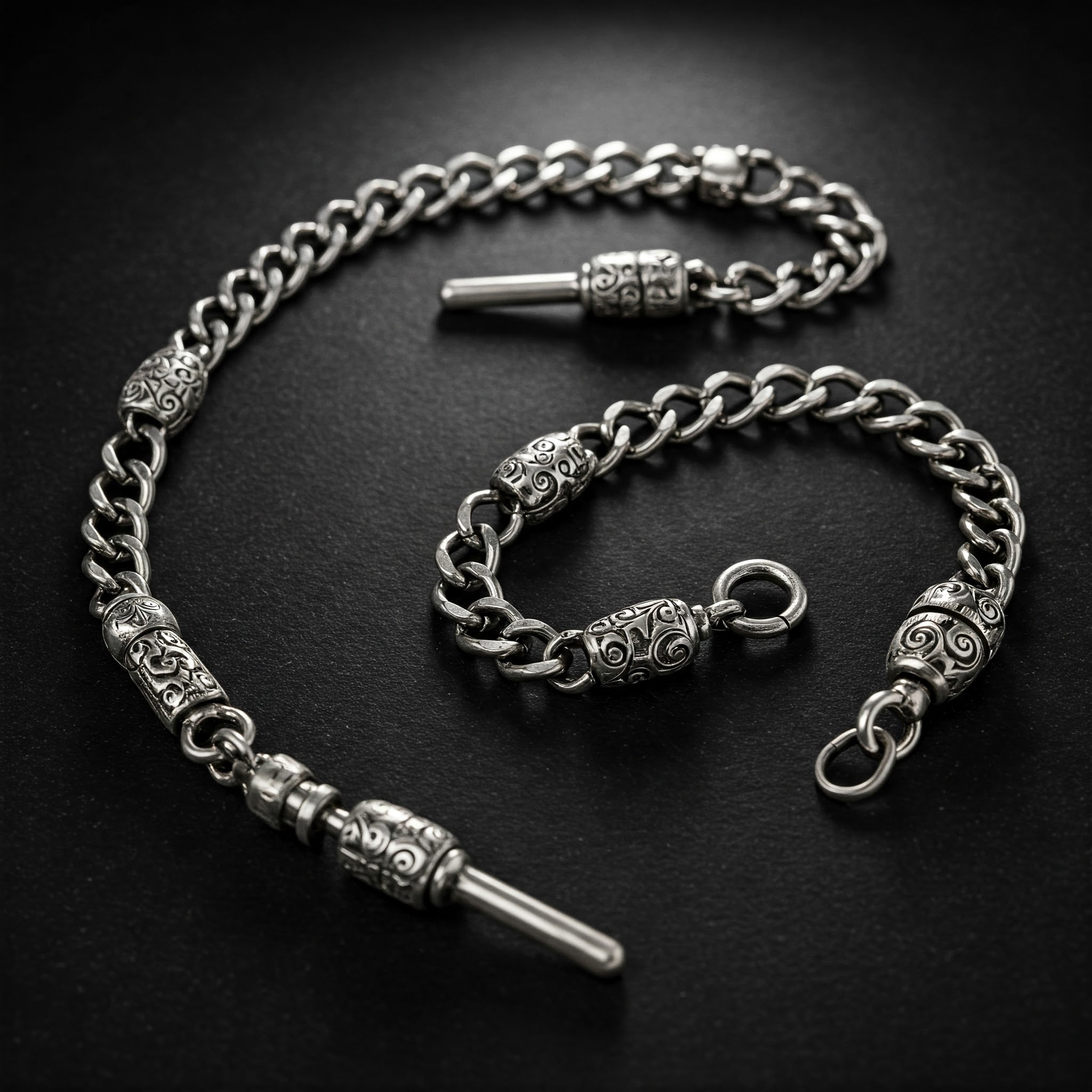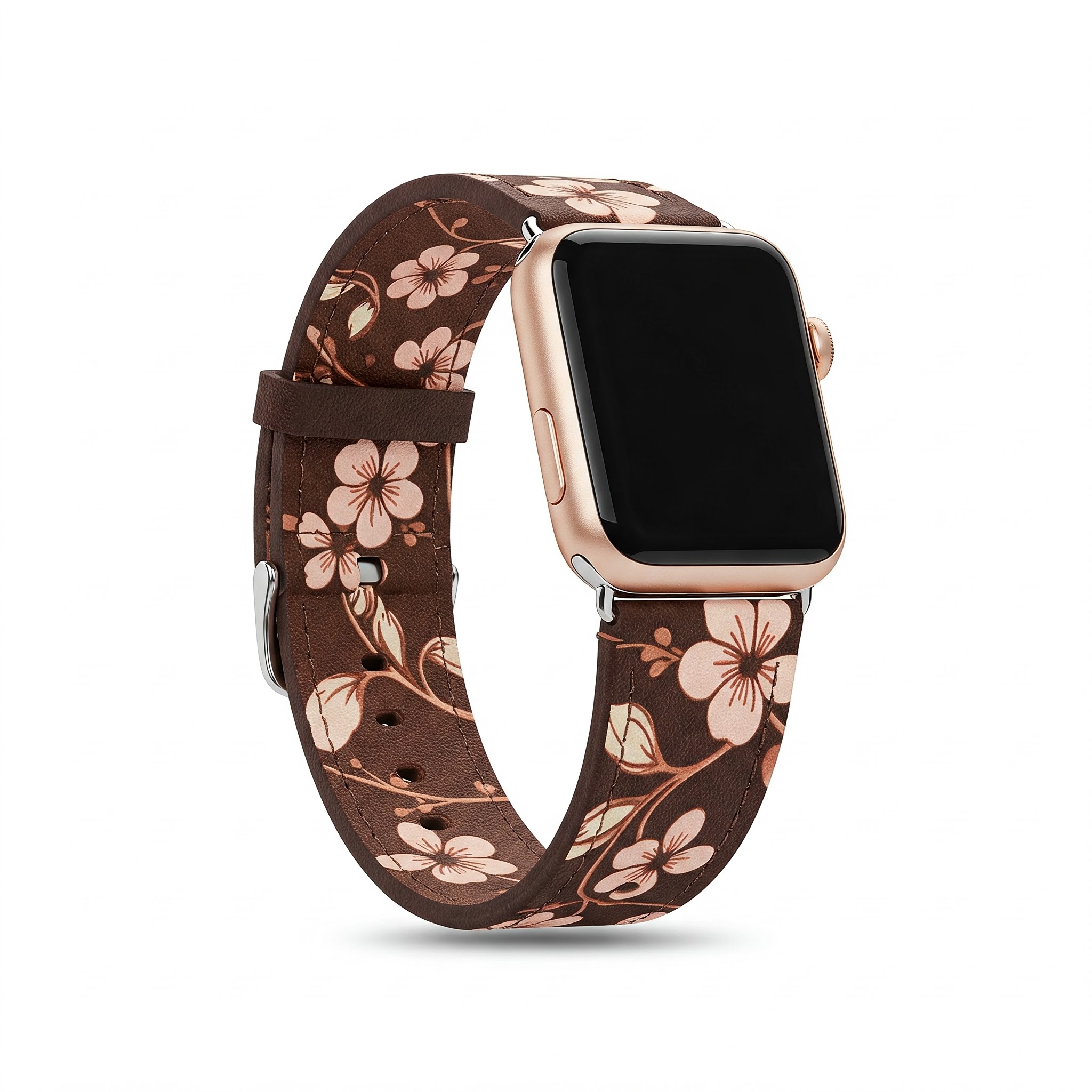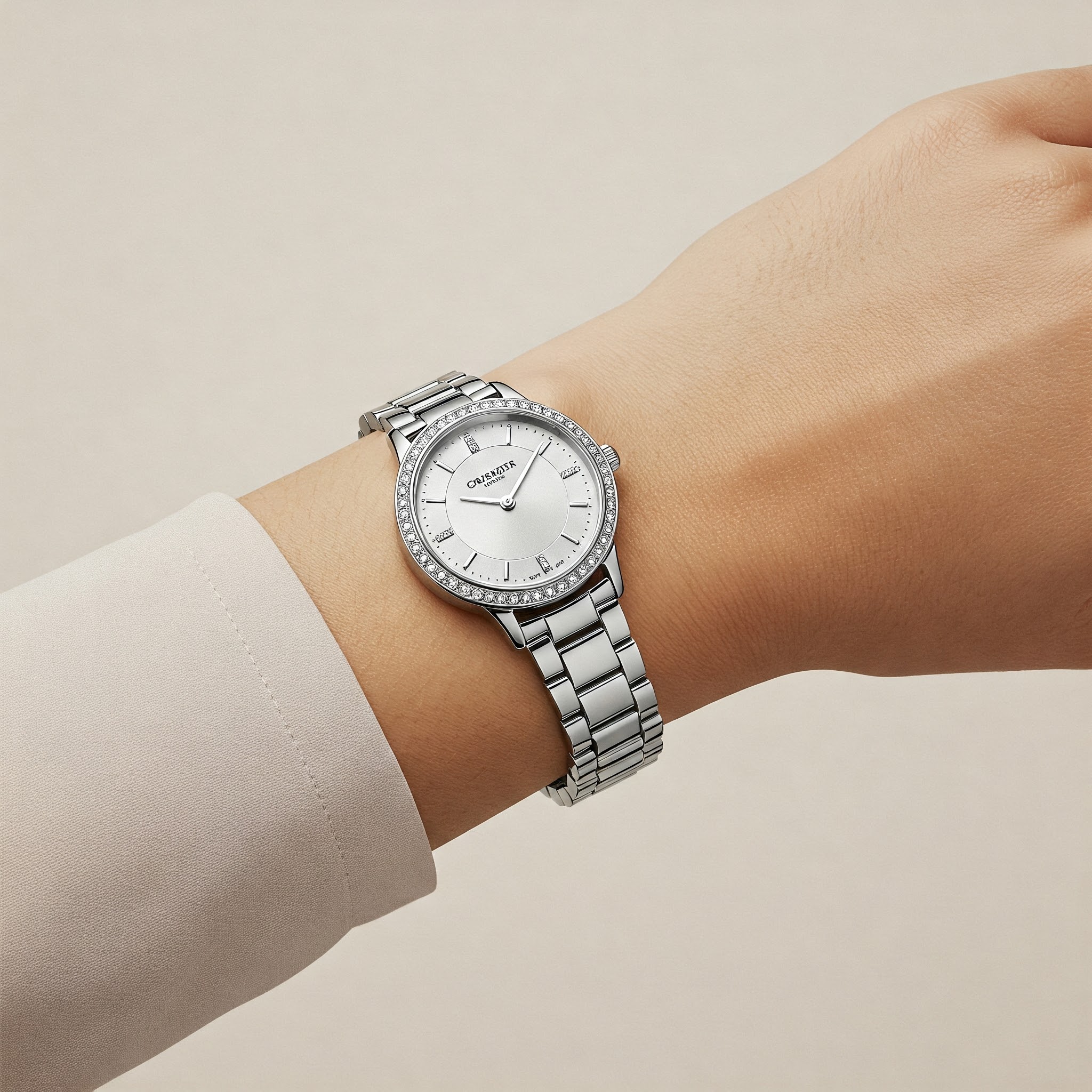In the world of classic accessories, few items capture the essence of refinement quite like a pocket watch chain. These elegant complements to traditional timepieces have served both functional and fashionable purposes for centuries, transforming a simple pocket watch into a statement of sophistication and personal style. Whether you’re a seasoned collector, a vintage fashion enthusiast, or simply curious about these timeless accessories, understanding the diversity and history of pocket watch chains can enhance your appreciation for these remarkable pieces.
✨Was this helpful? Spread the word! 🚀
The pocket watch chain isn’t merely a practical tool for securing valuable timepieces—it’s a reflection of heritage, craftsmanship, and individual character. Throughout history, these chains have evolved in design, material, and significance, becoming treasured heirlooms passed through generations. From the ornate gold Albert chains of Victorian gentlemen to the sturdy nickel variants worn by railroad workers in early America, each style tells a unique story about its era and wearer.
Today’s resurgence of interest in pocket watch chains represents more than nostalgia—it signals an appreciation for enduring quality and distinctive style in an age of mass production. Whether incorporated into contemporary fashion statements or cherished as collectibles, these chains continue to fascinate with their blend of functionality and artistic merit.
In this comprehensive guide, we’ll explore the fascinating world of pocket watch chains—examining their historical significance, identifying key styles and materials, offering practical advice for selection and care, and showcasing how these classical accessories can complement modern wardrobes. Join me on this journey through time as we uncover the enduring allure of the pocket watch chain.
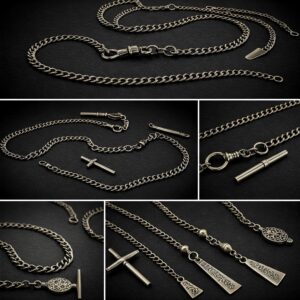
The Rich History of Pocket Watch Chains: From Necessity to Fashion Statement 🕰️
The evolution of pocket watch chains traces a fascinating journey through centuries of changing fashion and practical necessity. Originally emerging as simple utilitarian items in the 16th century, these chains served the essential purpose of preventing valuable timepieces from falling and sustaining damage. According to the National Association of Watch and Clock Collectors, the earliest documented pocket watch chains were basic cords or ribbons, far from the elaborate metal creations we recognize today.
By the 18th century, pocket watch chains began transforming into status symbols, particularly among European aristocracy. Crafted from precious metals and often adorned with gems or intricate engravings, these chains signaled wealth and social standing. The Victorian era (1837-1901) marked the golden age of pocket watch chains, when they reached their zenith in both popularity and design sophistication.
The Albert chain, named after Prince Albert, husband of Queen Victoria, emerged as perhaps the most iconic style during this period. This double-chain design featured a bar at one end for securing to a waistcoat buttonhole, with the watch attached to one chain and personal items like keys or fobs attached to the other. Research published in the Journal of Victorian Culture indicates that these chains became so popular that they influenced men’s fashion, with waistcoats specifically designed to showcase them.
In America, the rise of railroads in the 19th century created a unique chapter in pocket watch chain history. Railroad workers required reliable timepieces for coordinating train schedules, and sturdy chains became mandatory professional equipment. These chains prioritized durability over decorative elements, typically crafted from silver or nickel rather than gold.
The early 20th century witnessed a gradual decline in pocket watch usage as wristwatches gained popularity, particularly after World War I when soldiers discovered the practicality of wrist-worn timepieces in combat. However, pocket watch chains never disappeared entirely, remaining popular among certain professionals and enthusiasts of classic style.
Today’s renewed interest in pocket watch chains connects to broader cultural trends valuing heritage craftsmanship and individual expression. Contemporary fashion designers like Ralph Lauren and Tom Ford have incorporated pocket watch chains into their collections, reinterpreting these historical accessories for modern audiences. According to statistics from The Vintage Watch Company, sales of pocket watches and their accompanying chains have increased by approximately 15% annually since 2015, demonstrating their enduring appeal.
The pocket watch chain’s journey from purely practical item to fashion statement and back to appreciated accessory illustrates how certain elements of style transcend their original purpose to become timeless symbols of refinement and taste.
Essential Types of Pocket Watch Chains: Finding Your Perfect Match 🔗
Understanding the distinct varieties of pocket watch chains is crucial for both collectors and casual enthusiasts. Each type offers unique aesthetic qualities and functional benefits that can complement different styles and occasions. Here’s a comprehensive breakdown of the most significant chain styles you’ll encounter:
The Albert Chain
Named after Prince Albert, this remains one of the most recognized and versatile pocket watch chain styles. The classic Albert features a T-bar at one end (for fastening to a waistcoat buttonhole) and typically splits into two parallel chains—one for the watch and another for decorative fobs or useful tools. Modern interpretations of the Albert chain maintain this fundamental design while sometimes incorporating contemporary materials or simplified aesthetics.
The Albert’s enduring popularity stems from its perfect balance of functionality and visual appeal. According to a 2022 survey by Antique Horology Magazine, approximately 45% of pocket watch collectors consider the Albert their preferred chain style, citing its classic proportions and versatility.
The Single Albert Chain
A streamlined variant of its namesake, the Single Albert features just one chain extending from the T-bar to the watch. This minimalist approach offers a cleaner silhouette while maintaining the secure attachment method of the original design. Single Alberts are particularly well-suited to modern fashion interpretations, where subtle vintage references often work better than more elaborate historical pieces.
The Double Albert Chain
Taking the opposite approach, the Double Albert elaborates on the basic design with two equal-length chains connecting to the center T-bar. Traditionally, one chain held the pocket watch while the other displayed a decorative fob or useful tool like a pocket knife or compass. This symmetrical arrangement creates a more pronounced visual statement across the waistcoat or vest.
Historical records from the British Horological Institute indicate that Double Albert chains were particularly popular among professionals who needed to carry multiple personal items, such as physicians who might attach medical instruments to the secondary chain.
The Leontine Chain
Less common but distinctive in appearance, the Leontine chain features a central slide or medal from which two chains extend—typically of unequal length. One chain connects to the pocket watch, while the other might hold keys, a pocket knife, or decorative fobs. The uniqueness of the Leontine lies in its asymmetrical design, creating a more dynamic visual impression than the balanced Albert styles.
The Belt Chain
Practical and robust, belt chains were designed to secure pocket watches to belts rather than waistcoats, making them particularly popular among working men who didn’t wear formal vests. These chains typically feature a sturdy hook or clip at one end and tend to be thicker and more durable than their waistcoat counterparts.
According to research by the National Watch and Clock Museum, belt chains saw particular popularity in America during the late 19th and early 20th centuries, especially among railroad workers and those in industrial professions.
The Dickens Chain
Named for its popularity during Charles Dickens’ era, this chain style is characterized by its delicate links and ornate craftsmanship. Typically shorter than Albert chains, Dickens chains often feature intricate filigree work or decorative elements between links. These chains focus more on aesthetic appeal than heavy-duty functionality, making them popular choices for special occasions rather than everyday wear.
The Fob Chain
While technically not always used with pocket watches, fob chains deserve mention for their historical significance and occasional crossover with watch chains. These shorter chains were primarily designed to display decorative fobs—small ornaments that could range from simple seals to elaborate miniature sculptures. Contemporary collectors sometimes adapt traditional fob chains for use with pocket watches, particularly when seeking a more distinctive or personalized look.
Each of these chain styles carries its own historical associations and practical considerations. When selecting a pocket watch chain, consider not just your personal aesthetic preferences but also practical factors like:
- Intended use: Daily wear requires durability, while special occasions might prioritize decorative elements
- Compatible clothing: Different chain styles work better with specific garments
- The watch itself: Heavier timepieces require sturdier chains
Understanding these distinctions helps ensure you select not just an attractive accessory, but one that functions properly while complementing your personal style and the specific pocket watch it will accompany.
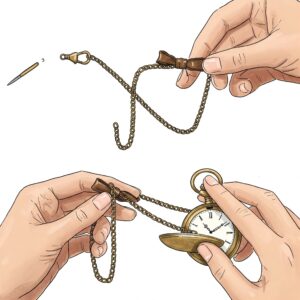
Materials Matter: Choosing Quality and Character in Your Pocket Watch Chain 💎
The material composition of a pocket watch chain significantly influences its appearance, durability, price point, and maintenance requirements. Historical and contemporary chains feature a diverse range of metals and manufacturing techniques, each offering distinct advantages and aesthetic qualities.
Gold and Gold-Filled Chains
Traditionally, high-quality pocket watch chains were crafted from solid gold, typically 9-18 karat. These premium chains offer unmatched warmth in color and develop a distinctive patina over decades of use. According to the American Watchmakers-Clockmakers Institute, genuine antique gold chains from the Victorian era can command prices ranging from $500 to several thousand dollars depending on their weight, craftsmanship, and historical significance.
Gold-filled chains provide a more accessible alternative while maintaining much of the appearance and durability of solid gold. These pieces feature a thick layer of gold bonded to a base metal core—significantly more substantial than modern gold plating. Many gold-filled chains from the early 20th century remain in excellent condition today, demonstrating their remarkable longevity when properly maintained.
The Elegance 14K Gold-Filled Albert Chain represents a premium modern interpretation of this classic material. With substantial weight and authentic vintage styling, this chain pairs beautifully with both antique and contemporary pocket watches. The warm gold tone complements formal attire particularly well, making it ideal for special occasions and professional settings.
Sterling Silver Chains
Silver pocket watch chains offer a distinctive bright luster that contrasts beautifully with gold or brass watch cases. Sterling silver (92.5% pure silver) provides excellent durability while developing a unique patina over time that many collectors prize. Silver chains were particularly popular during the Arts and Crafts movement of the early 20th century, when their malleability allowed for intricate decorative patterns.
Research from the Silver Institute indicates that properly maintained sterling silver chains can last for generations, though they do require occasional polishing to remove tarnish—a characteristic oxidation process that actually helps protect the underlying metal.
Stainless Steel and Contemporary Metals
Modern pocket watch enthusiasts often opt for stainless steel chains, which offer exceptional durability, tarnish resistance, and affordability. While lacking some of the traditional character of precious metals, quality stainless steel chains provide reliable functionality with minimal maintenance requirements. These chains are particularly suitable for everyday wear or for complementing contemporary pocket watch designs.
The Heritage Stainless Steel Double Chain combines traditional styling with modern materials, offering excellent value for those entering the world of pocket watches. Its substantial links and secure clasp provide reliable protection for timepieces while maintaining a classic aesthetic that works well with both casual and semi-formal attire.
Base Metal and Plated Chains
At the most accessible price point, base metal chains (typically brass, copper, or zinc alloys) with decorative plating offer the appearance of more precious metals at a fraction of the cost. While these won’t develop the same cherished patina or last as many generations as their precious metal counterparts, quality plated chains can serve admirably for occasional wear or as starter pieces for new collectors.
Historical evidence from the Museum of London’s collection shows that even in the Victorian era, plated chains were common among the middle classes, suggesting that the practice of creating more affordable versions of luxury accessories has a long tradition.
Link Types and Construction
Beyond the base material, the construction technique significantly impacts a chain’s appearance and durability:
- Curb links: Uniform, interlocking links that lie flat when spread out
- Cable links: Tightly wound wire resembling rope or cable
- Figaro links: Alternating pattern of long and short links
- Byzantine links: Complex, interwoven links creating a substantial, textured appearance
Each link style creates a distinct visual impression and affects how the chain hangs and moves. According to a study published in the Journal of Antique Metalwork, curb links tend to be the most durable for everyday use, while more complex patterns may require more careful handling to prevent stretching or damage.
When selecting a pocket watch chain material, consider not just your budget but also:
- How frequently you’ll wear the chain
- Whether you prefer a “lived-in” patina or pristine appearance
- The metal of your pocket watch (complementary or contrasting)
- Any metal sensitivities you might have
By understanding the characteristics of different materials, you can select a chain that not only looks appealing initially but will continue to meet your expectations throughout years of use.
How to Wear a Pocket Watch Chain: Styling Tips for Modern Elegance 👔
Incorporating a pocket watch chain into contemporary attire requires understanding both historical traditions and modern fashion sensibilities. Whether you’re aiming for authentic vintage style or a subtle nod to classical elegance, the way you wear your chain significantly impacts the overall effect.
Traditional Waistcoat Styling
The most classic approach involves wearing your pocket watch chain with a formal waistcoat (vest). According to sartorial guidelines from Gentleman’s Gazette, the traditional method follows these steps:
- Secure the T-bar or bolt ring to a buttonhole of your waistcoat, typically the middle or second-from-top button
- Run the chain across your midsection in a gentle arc (never pulled tight)
- Place the pocket watch in your waistcoat pocket (traditionally the left side)
- If using a Double Albert chain, the secondary chain can hold a decorative fob or useful tool in the opposite pocket
This arrangement creates the distinctive curved silhouette seen in period photographs and paintings of Victorian and Edwardian gentlemen. For formal events like weddings or black-tie affairs, this traditional styling remains the gold standard for pocket watch presentation.

Contemporary Adaptations
For everyday wear or less formal occasions, modern enthusiasts have developed several adaptations that maintain the spirit of pocket watch chains while working with contemporary clothing:
Suit Jacket Styling: Without a waistcoat, a pocket watch chain can be worn with a suit by securing the T-bar to a buttonhole of your jacket and placing the watch in an interior breast pocket. This creates a more subtle display of the chain while keeping your timepiece accessible.
Jeans and Casual Wear: The Vintage Keeper Belt Loop Chain exemplifies how these accessories can complement casual attire. This sturdy chain secures to a belt loop rather than a buttonhole, with the watch tucked into a front pocket of your jeans or trousers. This rugged interpretation works particularly well with American heritage workwear styles.
Fashion designer Todd Snyder notes in his style guide that pocket watch chains can add “a touch of unexpected sophistication to even the most casual ensembles,” suggesting their versatility extends far beyond formal occasions.
Length and Positioning Considerations
The proper length of your chain depends on both your physique and your intended wearing style. For traditional waistcoat wear, the chain should form a gentle arc across your midsection—neither pulled taut nor hanging in a deep U-shape. Most standard Albert chains range from 12-15 inches, but custom lengths may better suit your specific proportions.
Research from the International Watch and Jewelry Guild suggests that the ideal positioning places the middle of the chain’s arc approximately at navel level, creating balanced proportions with most body types.
Complementary Accessories
For maximum impact, consider how your pocket watch chain interacts with other accessories:
- Metal matching: Traditionally, your chain should complement other metal elements in your outfit, including cufflinks, tie bars, and belt buckles
- Watch selection: The style and period of your pocket watch should reasonably match your chain (though perfect historical accuracy isn’t always necessary)
- Fobs and decorative elements: These can personalize your look but should be chosen carefully to avoid overwhelming the chain itself
According to style expert Alan Flusser, author of “Dressing the Man,” the key to successful accessorizing is “harmony without uniformity”—your chain should complement your overall look without drawing excessive attention to itself.
Gender-Neutral Styling
While historically associated with men’s fashion, pocket watch chains have a rich tradition in women’s attire as well. During the late 19th century, ladies often wore longer chain styles called “chatelaines” that suspended watches, keys, and other items from a waistband or belt.
Contemporary fashion embraces this gender-fluid history. Designer Rachel Antonoff has incorporated pocket watch chains into women’s suits and dresses in recent collections, demonstrating their versatility across gender expressions.
By understanding these various styling approaches, you can incorporate a pocket watch chain into your wardrobe in ways that feel both authentic to the accessory’s heritage and appropriate for modern contexts. Whether worn as a statement piece or subtle detail, the right pocket watch chain adds a distinctive touch of personality and refinement to your attire.
📊 Comparing Top Pocket Watch Chain Options
When evaluating pocket watch chains, several key factors determine both quality and suitability for your specific needs. The following comparison table highlights notable options across different materials, styles, and price points:
| Chain Name | Material | Style | Length | Price Range | Best For |
|---|---|---|---|---|---|
| Elegance 14K Gold-Filled Albert | 14K Gold-Filled | Double Albert | 14″ | $120-150 | Special occasions, formal wear |
| Heritage Stainless Steel Double Chain | Stainless Steel | Double Albert | 15″ | $45-60 | Everyday durability, modern styling |
| Victorian Treasure Sterling Silver | Sterling Silver | Single Albert | 12″ | $85-110 | Vintage enthusiasts, silver watch pairings |
| Vintage Keeper Belt Loop Chain | Brass with Antique Finish | Belt Chain | 16″ | $35-50 | Casual wear, workwear aesthetic |
| Legacy Curb Link Gold-Tone | Brass with Gold Plating | Curb Link | 14″ | $30-45 | Budget-friendly formal option |
💬 Just one click – help others make better buying decisions too!😊
💫 Discover Your Perfect Chain Today! 💫
➡ Ready to complete your pocket watch collection with the ideal chain? Click on any of our recommended products to check current pricing and availability. Whether you’re a serious collector or just beginning your journey into vintage timepieces, the right chain transforms a simple watch into a distinguished accessory! 🕰️🔗
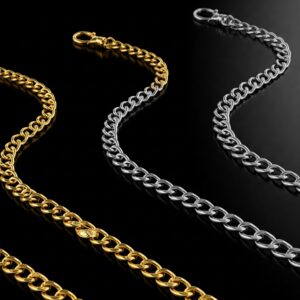
How to Select Your Ideal Pocket Watch Chain: A Buyer’s Guide 🛒
Finding the perfect pocket watch chain involves considering several critical factors to ensure you select a piece that meets your practical needs, aesthetic preferences, and budget constraints. Whether purchasing your first chain or adding to a collection, this systematic approach will help you make an informed decision.
Compatibility with Your Timepiece
The primary function of any pocket watch chain is to securely hold your watch, making compatibility essential. Consider:
- Watch size and weight: Heavier antique watches require sturdier chains with secure clasps
- Attachment mechanism: Ensure your chain has the appropriate hook, swivel, or clip for your watch’s bow
- Historical accuracy: If maintaining period authenticity matters to you, research chains typical of your watch’s era
According to restoration experts at the American Watchmakers-Clockmakers Institute, many vintage pocket watches show damage from being paired with inappropriate chains. A chain that’s too light for a heavy watch risks breaking, while overly heavy chains can stress the watch’s attachment points.
Quality Indicators
Discerning quality in pocket watch chains requires attention to several key details:
- Link construction: Examine how links connect—soldered joins typically indicate higher quality than simply bent metal
- Clasp security: Test the T-bar, swivel clasps, or spring rings for smooth operation and secure closure
- Weight: Substantial weight often (though not always) correlates with better materials and construction
- Hallmarks: On precious metal chains, look for quality marks indicating metal purity (e.g., “925” for sterling silver)
The Elegance 14K Gold-Filled Albert Chain exemplifies superior craftsmanship with its solid construction, precisely soldered links, and authentic period styling. Each link demonstrates careful finishing, creating smooth edges that won’t catch on clothing—a hallmark of quality chain production.
Investment Value Considerations
Some purchasers view pocket watch chains not just as accessories but as investments. If this aspect interests you:
- Precious metals: Gold and sterling silver chains tend to retain or increase value over time
- Provenance: Chains with documented history or from notable makers command premium prices
- Condition: Original fitments without repairs generally maintain better value
- Rarity: Unusual designs or limited production examples appreciate more predictably
Research from Heritage Auctions indicates that fine pocket watch chains have appreciated approximately 5-7% annually over the past decade, outperforming many traditional investment vehicles.
Practical Usage Factors
How and where you plan to wear your chain should significantly influence your selection:
- Frequency of use: Daily wear demands greater durability than occasional use
- Activity level: More active lifestyles require secure clasps and stronger links
- Clothing compatibility: Different chain styles work better with specific garments
- Maintenance willingness: Some materials require more care than others
The Heritage Stainless Steel Double Chain offers exceptional durability for regular wear, with corrosion-resistant material that requires minimal maintenance while providing reliable security for your timepiece in various conditions.
Personal Style Considerations
Beyond practical concerns, your pocket watch chain should complement your personal aesthetic:
- Period consistency: Some enthusiasts prefer chains matching their watch’s era
- Metal coordination: Traditionally, chains should complement other metal accessories
- Subtlety vs. statement: Consider whether you want your chain to be a focal point or subtle accent
- Decorative elements: Fobs, charms, or ornate links add personality but also visual weight
💥 Don’t Miss These Exceptional Chain Options! 💥
➡ Ready to elevate your timepiece with the perfect chain? Click on any of the highlighted products above to check current pricing and availability on Amazon. These carefully selected chains represent the finest options in their respective categories, combining historical authenticity with modern quality standards! 🔗⌚
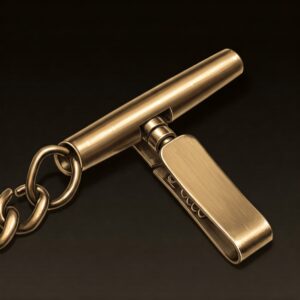
Proper Care and Maintenance: Preserving Your Pocket Watch Chain’s Beauty 🧹
Ensuring the longevity of your pocket watch chain requires appropriate maintenance tailored to its specific material and construction. Proper care not only preserves appearance but also maintains structural integrity for continued safe use with valuable timepieces.
Cleaning Different Chain Materials
Each material requires specific cleaning approaches to prevent damage:
Gold and Gold-Filled Chains
For these precious metal chains, gentle cleaning is essential. Create a solution of warm water with a few drops of mild dish soap, then:
- Soak the chain briefly (1-2 minutes)
- Gently scrub with a soft-bristled toothbrush, paying special attention to link crevices
- Rinse thoroughly with clean water
- Pat dry with a lint-free cloth
- Allow to air dry completely before storage
For stubborn tarnish or buildup in intricate patterns, The Goldsmiths’ Company recommends ultrasonic cleaners set to low intensity, though caution is warranted with very old or delicate chains.
Sterling Silver Chains
Silver chains require specific care to address tarnish—the natural darkening that occurs through oxidation. For basic cleaning:
- Use a dedicated silver polish like Hagerty Silver Foam
- Apply with a soft cloth following product directions
- Rinse thoroughly and dry completely
For chains with significant detail work where polish is difficult to remove, a silver dip solution may work better, though these should be used sparingly as they can be quite aggressive.
Stainless Steel and Base Metal Chains
These more robust materials can withstand slightly more vigorous cleaning:
- Create a solution of warm water and mild dish soap
- Use a soft brush to clean between links
- Rinse thoroughly and dry immediately to prevent water spots
- For additional shine, a dedicated metal polish appropriate for the specific material can be applied
Storage Recommendations
Proper storage prevents tangling, scratching, and premature tarnishing:
- Individual storage: Keep chains separated from other jewelry to prevent scratching
- Anti-tarnish material: Store silver and brass chains with anti-tarnish strips or in anti-tarnish cloth bags
- Humidity control: Keep precious metal chains in environments with stable humidity to slow oxidation
- Flat storage: Hang or lay chains flat rather than bunching them, which can stress links over time
The British Horological Institute recommends storing pocket watch chains separate from their watches when not in use, as this reduces stress on both the chain attachment points and the watch’s bow.
Wear and Tear Prevention
Even with careful use, pocket watch chains face certain stresses:
- Regular inspection: Check links and clasps monthly for signs of wear or loosening
- Rotation: If you own multiple chains, rotate their use to minimize wear on any single piece
- Activity awareness: Remove chains during vigorous physical activity or where they might catch on equipment
- Professional maintenance: Have valuable chains inspected by a jeweler annually
Research published in the Journal of Conservation and Museum Studies indicates that the most common failure points in antique chains are clasps and connection points rather than the chains themselves. These vulnerable areas deserve particular attention during inspections.
Repair Considerations
When damage does occur, appropriate repair approaches preserve both function and value:
- Professional repair: For precious metal or antique chains, always seek a jeweler specializing in vintage pieces
- Link replacement: When possible, replace damaged links rather than attempting repair of compromised metal
- Clasp upgrades: Consider upgrading clasps on valuable chains to more secure modern versions while preserving the original for historical integrity
- Documentation: Keep records of any repairs or modifications, particularly for chains with investment or historical value
For chains of significant historical or monetary value, specialists at the Society of American Silversmiths recommend consulting with conservation professionals rather than general jewelry repair services to ensure appropriate techniques and materials.
By implementing these care practices, your pocket watch chain can remain both beautiful and functional for generations, potentially becoming an heirloom piece that carries both monetary and sentimental value forward through time.
Pocket Watch Chains as Collectibles: Value, Rarity, and Investment Potential 💰
For many enthusiasts, pocket watch chains represent not just fashionable accessories but valuable collectibles with significant investment potential. Understanding the factors that determine collectible value can help both casual and serious collectors make informed decisions.
Historical Significance and Provenance
Chains with documented historical connections command premium prices in the collector market. According to Christie’s Auction House, pocket watch chains with provenance linking them to historical figures or events can sell for 10-20 times the value of comparable pieces without such connections.
Factors that enhance historical value include:
- Original documentation: Sales receipts, gift inscriptions, or family records
- Photographic evidence: Period photographs showing the chain in use
- Connection to notable figures: Chains owned by important historical personalities
- Association with significant events: Chains linked to major historical moments
The authentication of such provenance typically requires expert evaluation and sometimes forensic analysis of materials and manufacturing techniques appropriate to the claimed period.
Maker and Design Significance
Certain manufacturers and designers produced chains of exceptional quality or innovative design that now hold special collector interest:
- Established jewelers: Chains from prestigious houses like Tiffany & Co., Cartier, or local jewelers of historical significance
- Patent designs: Chains featuring innovative mechanisms or unique construction methods
- Artistic movements: Chains reflecting distinct design periods like Art Nouveau, Art Deco, or Arts and Crafts
- Regional distinctiveness: Chains exhibiting characteristics specific to particular countries or regions
Research by the National Association of Watch and Clock Collectors indicates that chains from established American manufacturers like Simmons or Larter & Sons typically command 30-50% premiums over unmarked chains of similar material and quality.
Material and Craftsmanship Evaluation
Beyond basic metal value, collectors assess several craftsmanship elements:
- Link complexity: More intricate link designs generally indicate higher craftsmanship levels
- Join quality: How links connect reveals much about manufacturing quality
- Fineness of detail: Inspection of any decorative elements for precision and artistry
- Evidence of hand work: Signs of individual craftsmanship rather than mass production
- Weight and substance: Appropriate heft for the material and design
The Victorian Treasure Sterling Silver chain exemplifies exceptional craftsmanship with its hand-finished links and precisely executed period design elements. Such attention to detail significantly enhances collectible appeal beyond simple material value.
Market Trends and Investment Considerations
The market for collectible pocket watch chains has shown consistent growth over recent decades, with several notable trends:
- Rising scarcity: As genuine period chains are lost, damaged, or placed in permanent collections, available inventory decreases
- Increasing knowledge base: Better research and documentation helps identify truly significant pieces
- Cross-collector interest: These items attract both watch collectors and jewelry enthusiasts, broadening the market
- Generational shifts: Renewed interest in vintage accessories among younger collectors expands the buyer pool
According to market analysis from Antiquorum Auctioneers, fine pocket watch chains have appreciated at an average annual rate of 6.8% over the past 15 years, outpacing many traditional investment vehicles while providing the added benefit of enjoyable ownership.
For those considering chains as investments, experts recommend:
- Condition priority: Focus on chains in excellent original condition rather than restored examples
- Complete sets: Chains sold with their original watches or fobs typically appreciate faster than individual pieces
- Documentation development: Actively research and document the provenance of significant pieces
- Material stability: Precious metal chains generally maintain more stable value than plated examples
Collecting Categories and Specialization
Many collectors focus on specific niches within the broader field of pocket watch chains:
- Period specialization: Focusing on chains from specific eras like Victorian or Art Deco
- Regional collection: Concentrating on chains from particular countries or regions
- Material focus: Collecting examples in specific metals or with particular gemstone embellishments
- Style concentration: Specializing in particular chain types like Albert chains or chatelaines
This specialization allows collectors to develop deeper expertise and often discover undervalued pieces within their area of focus. According to The International Watch and Jewelry Guild, specialized collectors typically achieve better long-term returns than generalists by identifying important pieces overlooked by broader market participants.
💫 Discover Your Perfect Chain Today! 💫
➡ Ready to complete your pocket watch collection with the ideal chain? Click on any of our recommended products to check current pricing and availability. Whether you’re a serious collector or just beginning your journey into vintage timepieces, the right chain transforms a simple watch into a distinguished accessory! 🕰️🔗
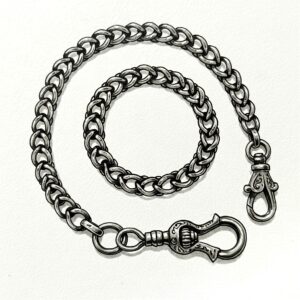
The Modern Revival: Pocket Watch Chains in Contemporary Fashion 🌟
The resurgence of pocket watch chains in today’s fashion landscape represents more than mere nostalgia—it reflects contemporary values around craftsmanship, individuality, and sustainable style choices. This revival manifests across various segments of modern culture, from haute couture to everyday streetwear.
Designer Reinterpretations
Leading fashion houses have embraced pocket watch chains as distinctive accessories that add character to contemporary collections. According to fashion industry publication WWD, pocket watch chains appeared in approximately 15% more men’s runway shows in 2023 compared to five years earlier, signaling their growing prominence.
Notable designer interpretations include:
- Thom Browne: Incorporating traditionally styled Albert chains into his signature cropped suits
- Gucci: Reimagining watch chains with colorful enamel details and oversized proportions
- Ralph Lauren: Featuring authentic vintage chains with his classic Americana collections
- Alexander McQueen: Creating darkly romantic chain designs with gothic influences
These high-fashion adaptations have helped reposition pocket watch chains from purely historical accessories to relevant components of contemporary wardrobes.
Street Style and Popular Culture
Beyond runway fashion, pocket watch chains have found their way into everyday style through several cultural channels:
- Vintage revival movements: The broader interest in heritage clothing styles has naturally incorporated watch chains
- Steampunk aesthetic: This genre’s blend of Victorian elements with science fiction has prominently featured elaborated watch chains
- Influencer adoption: Style influencers on platforms like Instagram have showcased creative ways to incorporate chains into modern outfits
Social media analytics from FashionSnoops indicate that hashtags related to pocket watch chains have seen a 78% increase in usage over the past three years, with particular growth among users aged 25-34—demonstrating appeal beyond traditional demographics.
Blending Function and Fashion
Today’s pocket watch chains often serve dual purposes, reflecting contemporary lifestyle needs:
- Tech adaptations: Some modern chains are designed to secure smartphones or digital devices rather than traditional watches
- Multi-functional design: Contemporary chains frequently incorporate useful tools like tiny USB drives or stylus tips
- Versatile wearing options: Modern chains often feature multiple attachment options for different garment styles
The Vintage Keeper Belt Loop Chain exemplifies this functional evolution, providing secure attachment for either traditional pocket watches or small everyday items while maintaining classical aesthetic elements. This versatility appeals particularly to younger consumers seeking both style and practicality.
Artisanal and Independent Makers
Perhaps the most significant aspect of the pocket watch chain revival is the emergence of independent craftspeople creating new chains using traditional techniques. Platforms like Etsy report that searches for handcrafted pocket watch chains increased by 127% between 2019 and 2023, indicating strong consumer interest in unique, handmade examples.
These artisanal makers often bring fresh perspectives to traditional designs:
- Metal fusion: Combining different metals for distinctive two-tone effects
- Upcycled materials: Repurposing vintage elements into new chain designs
- Customization options: Offering personalized details like initials or birthstones
- Alternative materials: Experimenting with non-traditional components like leather or sustainable materials
According to interviews published in Craft & Design Magazine, many of these independent creators come from jewelry-making backgrounds but are specifically drawn to pocket watch chains for their blend of functionality, history, and creative potential.
Sustainability and Ethical Considerations
The revival of pocket watch chains also connects with growing consumer interest in sustainable and ethical fashion choices. Unlike disposable accessories, quality chains represent:
- Multi-generational durability: Well-made chains can last for decades or centuries
- Repair-friendly construction: Traditional link designs can be maintained and repaired indefinitely
- Material recyclability: Precious metals remain valuable and reusable regardless of age
- Investment purchasing: Higher initial cost but superior long-term value compared to disposable alternatives
Research from The Sustainable Fashion Forum indicates that accessories with multi-generational potential like pocket watch chains align with changing consumer values, particularly among younger buyers concerned about fast fashion’s environmental impact.
Practical Guide: Pairing Your Watch with the Perfect Chain 🔎
Creating a harmonious combination of pocket watch and chain requires attention to several key factors, balancing historical authenticity with personal style and practical requirements.
Historical Compatibility
For collectors and enthusiasts concerned with period accuracy, matching your watch with an historically appropriate chain enhances both authenticity and potential value:
- Victorian watches (1837-1901): Pair with Albert chains, particularly double Alberts for men’s watches and longer slide chains for women’s timepieces
- Edwardian pieces (1901-1910): Slightly lighter, more elegant chains with Art Nouveau influences
- Art Deco watches (1920s-30s): Geometric link patterns and platinum or white gold for higher-end pieces
- Railroad watches: Sturdier nickel or silver chains with simple, functional designs
- Military timepieces: Often paired with simpler chains that could be tucked securely inside uniforms
According to research from the National Watch and Clock Museum, authentic period pairings can increase the value of vintage watch sets by 15-30% compared to mismatched combinations.
Physical Considerations
Beyond historical matching, practical physical compatibility ensures both security and appropriate aesthetics:
- Weight balance: Heavier watches require proportionally substantial chains
- Attachment mechanism: Ensure your watch’s bow (the ring at the top) accommodates your chain’s clasp style
- Length appropriateness: Chain length should suit both your physique and wearing style
- Finish matching: While not mandatory, complementary metal colors create a more cohesive appearance
The Heritage Stainless Steel Double Chain offers an excellent balance of strength and style for medium to larger pocket watches, with a robust clasp mechanism that securely attaches to most standard watch bows while maintaining an elegant profile.
Style Harmonization
Creating a visually pleasing combination involves several stylistic elements:
- Design era consistency: Matching the artistic periods of both pieces creates natural harmony
- Decoration levels: Very ornate watches often pair better with simpler chains to avoid visual competition
- Case and chain metal: Traditionally, these would match or complement each other
- Purpose alignment: Dress watches deserve dressier chains, while tool watches pair better with sturdier styles
According to style guidance from The Gentleman’s Gazette, even when perfect historical matching isn’t possible, maintaining consistent decorative “language” between watch and chain creates a more sophisticated presentation.
Conclusion: The Enduring Legacy of Pocket Watch Chains ✨
The pocket watch chain stands as a testament to how functional accessories can transcend their practical origins to become enduring symbols of refinement and personal style. Through centuries of evolution—from simple security devices to elaborate status symbols and back to appreciated accessories—these chains have maintained their essential character while adapting to changing fashions and needs.
Today’s renewed appreciation for pocket watch chains reflects broader cultural shifts toward quality, heritage, and individuality in personal style. Whether displayed with vintage timepieces as collectors’ items, incorporated into contemporary fashion as distinctive accessories, or treasured as family heirlooms connecting generations, these chains continue to fascinate and delight.
For those newly discovering the world of pocket watch chains, the journey offers multiple rewards: the pleasure of owning and wearing beautifully crafted objects, the intellectual satisfaction of understanding their historical context, and potentially the financial benefit of wise collecting decisions. Each chain, whether antique or newly crafted, carries its own story and adds to the narrative of this enduring accessory.
As we’ve explored throughout this guide, selecting the right pocket watch chain involves consideration of numerous factors—from material and construction to style and historical accuracy. Yet beyond these technical aspects lies the more intangible quality that has sustained interest in these accessories for centuries: their ability to connect us with traditions of craftsmanship and personal expression that remain relevant despite our rapidly changing world.
Whether you’re a serious collector, a fashion enthusiast, or simply someone who appreciates objects made to last, the pocket watch chain offers a tangible link to both history and timeless style—a small but significant reminder that some things of beauty and quality never truly go out of fashion.
🌟 Elevate Your Style With The Perfect Chain Today! 🌟
➡ Don’t wait to experience the distinctive elegance that only a quality pocket watch chain can provide. Explore our recommended selections to find the perfect match for your timepiece and personal style. These carefully curated options represent the finest examples available, combining historical authenticity with contemporary quality standards! 🔗⭐
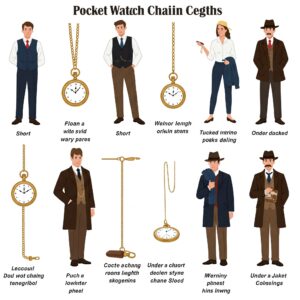
More FAQs
❓ How do I clean a gold pocket watch chain without damaging it?
✅ Use warm water with mild dish soap, gently scrubbing with a soft toothbrush between links. Rinse thoroughly, pat dry with a lint-free cloth, and allow to air dry completely. For valuable antique chains, consider professional cleaning to prevent damage...
❓ What is the best pocket watch chain for everyday use?
✅ Stainless steel or sterling silver chains offer the best durability for daily wear. Look for solid links, secure clasps, and comfortable weight. Albert-style chains provide versatility, while belt chains offer practical security for more active lifestyles...
❓ Can I wear a pocket watch chain with modern clothes?
✅ Absolutely! Pair with jeans by attaching to belt loops, with suits by securing to lapel buttonholes, or with waistcoats in traditional style. Modern interpretations include shorter chains for breast pockets and minimalist designs for contemporary aesthetics...
❓ How much should I expect to pay for a quality pocket watch chain?
✅ Quality starter chains in stainless steel begin around $35-60, while sterling silver options range from $80-150. Gold-filled chains typically cost $120-250, with solid gold antiques starting at $500. Investment pieces with historical significance or from notable makers can command $1,000+...
❓ What's the difference between Albert, Double Albert, and Single Albert chains?
✅ The Single Albert features one chain running from a T-bar to a pocket watch. Double Albert has two parallel chains, traditionally one for the watch and one for a fob or tool. The standard Albert typically refers to the double style, named after Prince Albert, Queen Victoria's husband...
Recommended for You:
- 7 Best Brighton Apple Watch Band Options For Ultimate Style in 2025
- 10 Best 20mm Watch Bands to Transform Your Timepiece in 2025
- 10 Best Watch Roll Options For Luxury Timepiece Storage in 2025
Disclaimer: This article contains affiliate links. If you purchase products through these links, we may earn a small commission at no additional cost to you.
✨ Found this helpful? Share it with your friends! 💬🤗

